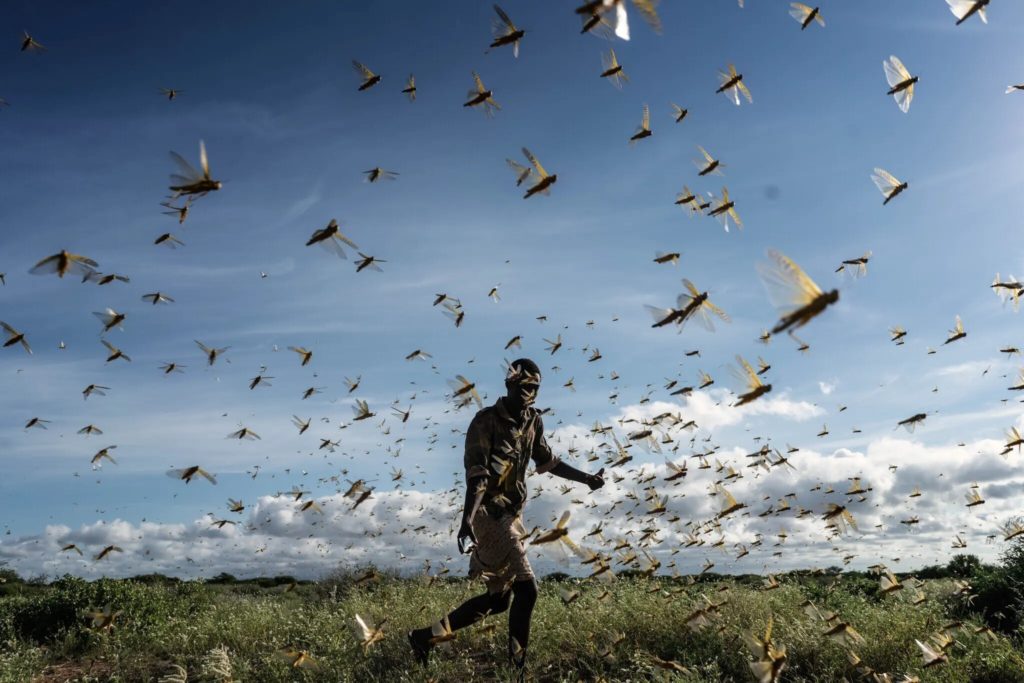In a world increasingly shaped by climate change, a new study suggests that rising temperatures may pave the way for a surge in locust populations, potentially imperiling crops across vast swathes. The findings, published in Science Advances, shed light on how climate shifts alter the dynamics of locust invasions, with profound implications for agriculture and food security.
Desert locusts, notorious for ravaging farmlands in northern Africa, the Middle East, and South Asia, thrive in hot, arid conditions punctuated by intermittent downpours. However, as human-induced warming accelerates, these regions are experiencing more frequent and intense bouts of drought and torrential rain – ideal conditions for locust breeding.
The study’s lead author, Xiaogang He, an assistant professor of civil and environmental engineering at the National University of Singapore, underscores the potential repercussions of this trend. “Given that these countries often serve as global breadbaskets and are already grappling with climate-driven extremes like droughts, floods, and heatwaves, the potential escalation of locust risks in these regions could exacerbate existing challenges,” he stated.
While warming temperatures may expand the locusts’ habitat, some experts argue that climate change could render certain areas unsuitable for survival. Christine N. Meynard, a researcher at the National Research Institute for Agriculture, Food, and Environment in Montpellier, France, suggests that hotter, drier conditions might restrict locust populations to smaller territories, facilitating more targeted pest control efforts.
Historically, much research shows a connection between the life cycles of locusts and weather patterns and ecological conditions. These insects typically lie dormant in arid regions until rainfall triggers a surge in vegetation, providing ample food for their offspring. Subsequent dry spells prompt the locusts to congregate and embark on mass migrations, devouring crops.
The catastrophic locust outbreaks of 2019 ravaged parts of East Africa and central India and underscored the vulnerability of agricultural systems to these voracious pests. The United Nations Food and Agriculture Organization mobilized a massive operation to mitigate the impact on food supplies and livelihoods.
He and his colleagues employed mathematical modeling techniques to understand how climate factors influence the spread of locust infestations. Their analysis revealed that the timing and distribution of seasonal rains play a pivotal role in synchronizing locust outbreaks across distant regions. Countries as distant as India and Morocco, or Pakistan and Algeria, could simultaneously face the scourge of locust plagues, posing a grave threat to global food security.
The researchers project that climate change could further exacerbate the locust menace, expanding their range by up to 25% by the end of the century. Regions currently unaffected by locusts, including parts of Afghanistan, India, Iran, and Turkmenistan, may become increasingly vulnerable to infestations.
Beyond climatic factors, experts emphasize the role of sociopolitical conditions in shaping locust risks. Conflict-ridden nations like Yemen have struggled to contain locust populations, exacerbating the impact of outbreaks on vulnerable communities. While challenges loom considerable, concerted efforts to monitor and manage locust populations offer a glimmer of hope. Dr. Meynard acknowledges progress in some countries but stresses the need for sustained vigilance and collaboration to safeguard global food supplies from the looming specter of locust invasions. As the world grapples with the complexities of climate change and its cascading effects, the battle against locusts is a stark reminder of the urgent need for coordinated action to protect agriculture and ensure food security for future generations.
